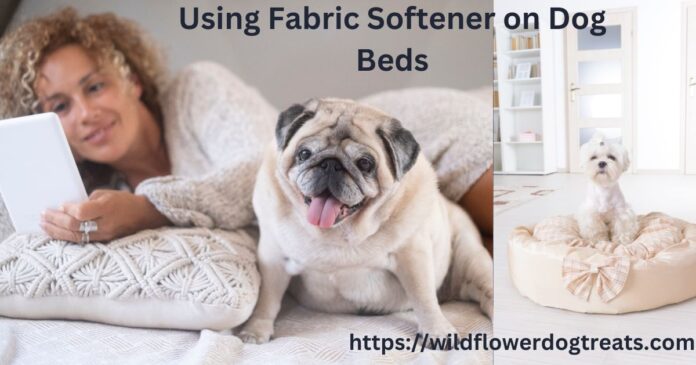Yes, you can use fabric softener on dog beds, but you should choose one that’s pet-friendly. Fabric softeners can help make your dog’s bed more comfortable and reduce static electricity, and some also contain natural ingredients that can repel insects.
Dog beds can get smelly and dirty, and using fabric softener can help keep them fresh and clean. However, it’s important to choose a fabric softener that is safe for pets, as some can contain chemicals that may be harmful to dogs.
Always check the label and opt for a pet-friendly fabric softener to ensure the safety of your pet. Additionally, consider using hypoallergenic and fragrance-free options to minimize any potential irritation for your furry friend. By following these guidelines, you can keep your dog’s bed soft and fresh without compromising their health and well-being.
Assessing Fabric Softener For Dog Beds
Importance Of Choosing Safe Cleaning Products
When it comes to keeping your furry friend’s bed clean and fresh, it’s essential to consider the importance of choosing safe cleaning products. Your dog’s bed is a place where they spend a large portion of their time, and using harsh or toxic chemicals can have a negative impact on their health and well-being.
Risks Associated With Improper Cleaning Agents
Using fabric softener on dog beds may seem like a harmless way to keep them soft and smelling great. However, it’s important to be aware of the risks associated with improper cleaning agents. Fabric softeners often contain chemicals and fragrances that can be harmful to your pet’s skin and respiratory system.
Decoding Fabric Softener Ingredients
Fabric softeners are commonly used to make clothing and linens feel softer and reduce static cling. However, when it comes to using fabric softener on dog beds, it’s important to consider the ingredients and their potential effects on your pet’s health and well-being. Decoding fabric softener ingredients can help pet owners make informed choices about caring for their furry friends’ bedding.
Chemical Components And Their Effects
Fabric softeners typically contain a variety of chemical components that contribute to their softening and static-reducing properties. Some common ingredients found in fabric softeners include:
- Quaternary ammonium compounds (quats): These are antimicrobial chemicals known for their fabric conditioning abilities, but they may cause skin irritation and respiratory issues in humans and pets.
- Fragrances: Many fabric softeners contain synthetic fragrances that can trigger allergies and skin sensitivities in dogs, leading to itchiness and discomfort.
- Silicone-based compounds: These substances provide a smooth feel to fabrics, but they can also leave a residue that attracts dirt and hair, potentially creating an unhygienic environment for pets.
Natural Vs. Synthetic Softeners
When considering fabric softeners for use on dog beds, pet owners may contemplate the choice between natural and synthetic softeners. Natural options, such as wool dryer balls or vinegar, provide a more pet-friendly alternative, as they are less likely to contain harmful chemicals. Synthetic softeners, on the other hand, often come with a higher risk of triggering allergic reactions and respiratory issues in pets due to their chemical composition.
Can Fabric Softener Be Dog-friendly?
Fabric softeners are a popular addition to laundry routines, leaving clothes soft, static-free, and with a fresh scent. However, when it comes to our furry friends and their bedding, it’s essential to consider the potential impact of fabric softener on their health and well-being. Using fabric softener on dog beds can provide numerous benefits, but it’s vital to ensure that the products used are safe and pet-friendly.
Identifying Pet-safe Fabric Softeners
When choosing a fabric softener for your dog’s bedding, it’s crucial to opt for a product that is specifically labeled as safe for pets. Look for fabric softeners that are free from toxic chemicals and additives that could be harmful to your dog’s skin and respiratory system. Natural and hypoallergenic options are ideal choices, as they are less likely to cause irritation or adverse reactions in sensitive pets.
Understanding Fragrance And Dye Implications
Fabric softeners often contain fragrances and dyes that can be problematic for dogs with allergies or sensitivities. opt for unscented or lightly scented fabric softeners to minimize the risk of triggering any adverse reactions in your furry companion. Additionally, be mindful of any dyes used in the product, as some dogs may be sensitive to certain coloring agents. Choosing dye-free fabric softeners can help reduce the potential for skin irritation or discomfort.
Tips For Safe Dog Bed Cleaning
When it comes to keeping your furry friend’s bed clean and fresh, it’s important to consider the safety of your dog. Using the right cleaning methods is crucial to ensure a comfortable and healthy environment for your pet. Here are some useful tips for safe dog bed cleaning that you can follow to maintain a clean and cozy sleeping space for your beloved canine companion.
Step-by-step Guide On Using Fabric Softener Correctly
While fabric softeners may seem like a suitable option to keep your dog’s bed smelling pleasant, it’s important to use them carefully to avoid any potential harm to your pet. Follow these steps to use fabric softener correctly:
- Choose a mild, pet-safe fabric softener that is free from harsh chemicals and fragrances.
- Use a minimal amount of fabric softener to prevent any skin irritation in your pet. Consult with your veterinarian if unsure.
- Dilute the fabric softener with water before adding it to the washing machine to further reduce its potency.
- Ensure that the fabric softener is thoroughly rinsed out of the dog bed during the wash cycle to prevent any residue from lingering.
Alternative Cleaning Methods For Dog Beds
If you prefer to avoid using fabric softener on your dog’s bed, there are alternative methods for effectively cleaning and freshening the bedding:
- Use a pet-safe laundry detergent that is free from harsh chemicals and fragrances.
- Opt for natural remedies such as baking soda or vinegar to neutralize odors without the use of potentially harmful chemicals.
- Regularly vacuum and spot clean the dog bed to remove any dirt, hair, and debris, maintaining a clean environment for your pet.
- Consider using a pet-friendly enzyme cleaner to effectively eliminate stains and odors from the dog bed.
Maintaining Cleanliness And Comfort
When it comes to your furry friend’s comfort and hygiene, their bedding plays a crucial role. Routine cleaning practices, appropriate materials, and care are essential to ensure cleanliness and comfort for your pet. Let’s delve into these aspects to learn more about maintaining a clean and cozy environment for your beloved dog.
Routine Cleaning Practices For Pet Hygiene
Cleaning your dog’s bed regularly is vital for maintaining a healthy living environment. Here are some key practices to consider:
- Vacuuming: Use a handheld vacuum or the brush attachment on your regular vacuum to remove hair, dirt, and debris from the bed’s surface.
- Spot cleaning: Quickly address any spills or accidents by spot cleaning with a pet-safe fabric cleaner. Blot the area with a clean cloth to remove excess moisture.
- Washing: Follow the manufacturer’s instructions for washing the bed cover, using a gentle, pet-friendly detergent. Make sure to air dry or tumble dry on a low setting to prevent damage to the material.
Selecting And Caring For Dog Bed Materials
Choosing the right materials for your dog’s bed is crucial for their comfort and overall well-being. Here’s what to consider:
| Material | Care Instructions |
|---|---|
| Memory Foam | Spot clean with a damp cloth or use a mild detergent for deeper cleaning. Air dry completely before placing the cover back on. |
| Canvas or Polyester | Machine wash with a gentle detergent, and tumble dry on low heat to avoid shrinking. |
| Fleece or Sherpa | Machine wash on a gentle cycle and tumble dry on low. Avoid using fabric softener as it may reduce the material’s plushness. |
Frequently Asked Questions On Can You Use Fabric Softener On Dog Beds
Can Fabric Softener Be Used On Dog Beds?
Yes, you can use fabric softener on dog beds, but it’s essential to choose a pet-safe, unscented option. Make sure to follow the instructions on the fabric softener bottle and use it sparingly to avoid any potential skin irritation for your furry friend.
How Often Should You Wash Your Dog’s Bed?
It’s recommended to wash your dog’s bed every 1-2 weeks to maintain cleanliness and hygiene. However, if your dog has skin issues, allergies, or is prone to accidents, more frequent washing may be necessary to prevent any potential health concerns for your pet.
Is It Safe To Use Scented Products On Dog Beds?
Using scented products on dog beds may cause skin irritation or allergic reactions in some dogs. It’s best to opt for unscented, pet-safe fabric softeners and detergents to avoid any potential harm to your pet’s sensitive skin and respiratory system.
What Are The Best Practices For Washing Dog Beds?
To wash dog beds effectively, start by removing excess hair and debris. Use a pet-safe detergent and fabric softener, wash on a gentle cycle, and air dry if possible. Check the care label for specific instructions and always use pet-friendly products to ensure your dog’s well-being.
Conclusion
Using fabric softener on dog beds may seem like a convenient idea, but it’s important to consider the potential risks. Opting for pet-friendly alternatives can ensure the safety and well-being of your furry friend. Prioritizing their health and comfort is key in maintaining a happy and healthy pet-friendly home.





